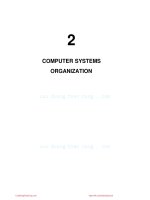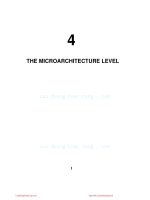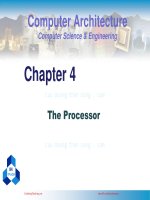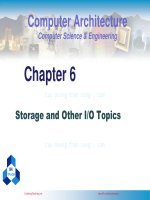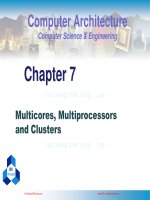kiến trúc máy tính nguyễn thanh sơn ch6 storage and other io topics sinhvienzone com
Bạn đang xem bản rút gọn của tài liệu. Xem và tải ngay bản đầy đủ của tài liệu tại đây (1.79 MB, 50 trang )
Computer Architecture
Computer Science & Engineering
Chapter 6
Storage and Other I/O Topics
BK
TP.HCM
CuuDuongThanCong.com
/>
Introduction
I/O devices can be characterized by
Behaviour: input, output, storage
Partner: human or machine
Data rate: bytes/sec, transfers/sec
I/O bus connections
BK
TP.HCM
22-Sep-13
CuuDuongThanCong.com
Faculty of Computer Science & Engineering
/>
2
I/O System Characteristics
Dependability is important
Particularly for storage devices
Performance measures
Latency (response time)
Throughput (bandwidth)
Desktops & embedded systems
Mainly interested in response time & diversity
of devices
Servers
BK
Mainly interested in throughput & expandability
of devices
TP.HCM
22-Sep-13
CuuDuongThanCong.com
Faculty of Computer Science & Engineering
/>
3
Dependability
Service accomplishment
Service delivered
as specified
Restoration
Failure
Fault: failure of a
component
May or may not lead
to system failure
Service interruption
Deviation from
specified service
BK
TP.HCM
22-Sep-13
CuuDuongThanCong.com
Faculty of Computer Science & Engineering
/>
4
Dependability Measures
Reliability: mean time to failure (MTTF)
Service interruption: mean time to repair (MTTR)
Mean time between failures
MTBF = MTTF + MTTR
Availability = MTTF / (MTTF + MTTR)
Improving Availability
Increase MTTF: fault avoidance, fault tolerance, fault
forecasting
Reduce MTTR: improved tools and processes for
diagnosis and repair
BK
TP.HCM
22-Sep-13
CuuDuongThanCong.com
Faculty of Computer Science & Engineering
/>
5
Disk Storage
Nonvolatile, rotating magnetic storage
BK
TP.HCM
22-Sep-13
CuuDuongThanCong.com
Faculty of Computer Science & Engineering
/>
6
Disk Sectors and Access
Each sector records
Sector ID
Data (512 bytes, 4096 bytes proposed)
Error correcting code (ECC)
Synchronization fields and gaps
Access to a sector involves
BK
Used to hide defects and recording errors
Queuing delay if other accesses are pending
Seek: move the heads
Rotational latency
Data transfer
Controller overhead
TP.HCM
22-Sep-13
CuuDuongThanCong.com
Faculty of Computer Science & Engineering
/>
7
Disk Access Example
Given
Average read time
512B sector, 15,000rpm, 4ms average seek
time, 100MB/s transfer rate, 0.2ms controller
overhead, idle disk
4ms seek time
+ ½ / (15,000/60) = 2ms rotational latency
+ 512 / 100MB/s = 0.005ms transfer time
+ 0.2ms controller delay
= 6.2ms
If actual average seek time is 1ms
Average read time = 3.2ms
BK
TP.HCM
22-Sep-13
CuuDuongThanCong.com
Faculty of Computer Science & Engineering
/>
8
Disk Performance Issues
Manufacturers quote average seek time
Smart disk controller allocate physical sectors
on disk
Present logical sector interface to host
SCSI, ATA, SATA
Disk drives include caches
BK
Based on all possible seeks
Locality and OS scheduling lead to smaller actual
average seek times
Prefetch sectors in anticipation of access
Avoid seek and rotational delay
TP.HCM
22-Sep-13
CuuDuongThanCong.com
Faculty of Computer Science & Engineering
/>
9
Flash Storage
Nonvolatile semiconductor storage
100× – 1000× faster than disk
Smaller, lower power, more robust
But more $/GB (between disk and DRAM)
BK
TP.HCM
22-Sep-13
CuuDuongThanCong.com
Faculty of Computer Science & Engineering
/>
10
Flash Types
NOR flash: bit cell like a NOR gate
NAND flash: bit cell like a NAND gate
Random read/write access
Used for instruction memory in embedded systems
Denser (bits/area), but block-at-a-time access
Cheaper per GB
Used for USB keys, media storage, …
Flash bits wears out after 1000’s of accesses
Not suitable for direct RAM or disk replacement
Wear leveling: remap data to less used blocks
BK
TP.HCM
22-Sep-13
CuuDuongThanCong.com
Faculty of Computer Science & Engineering
/>
11
Interconnecting Components
Need interconnections between
Bus: shared communication channel
BK
Parallel set of wires for data and
synchronization of data transfer
Can become a bottleneck
Performance limited by physical factors
CPU, memory, I/O controllers
Wire length, number of connections
More recent alternative: high-speed
serial connections with switches
Like networks
TP.HCM
22-Sep-13
CuuDuongThanCong.com
Faculty of Computer Science & Engineering
/>
12
Bus Types
Processor-Memory buses
Short, high speed
Design is matched to memory organization
I/O buses
Longer, allowing multiple connections
Specified by standards for interoperability
Connect to processor-memory bus through
a bridge
BK
TP.HCM
22-Sep-13
CuuDuongThanCong.com
Faculty of Computer Science & Engineering
/>
13
Bus Signals and Synchronization
Data lines
Control lines
Uses a bus clock
Asynchronous
BK
Indicate data type, synchronize transactions
Synchronous
Carry address and data
Multiplexed or separate
Uses request/acknowledge control lines for
handshaking
TP.HCM
22-Sep-13
CuuDuongThanCong.com
Faculty of Computer Science & Engineering
/>
14
I/O Bus Examples
Firewire
USB 2.0
PCI Express
Serial ATA
Serial
Attached
SCSI
Intended use External
External
Internal
Internal
External
Devices per
channel
63
127
1
1
4
Data width
4
2
2/lane
4
4
Peak
bandwidth
50MB/s or
100MB/s
0.2MB/s,
1.5MB/s, or
60MB/s
250MB/s/lane 300MB/s
1×, 2×, 4×,
8×, 16×, 32×
300MB/s
Hot
pluggable
Yes
Yes
Depends
Yes
Yes
Max length
4.5m
5m
0.5m
1m
8m
Standard
IEEE 1394
USB
Implementers
Forum
PCI-SIG
SATA-IO
INCITS TC
T10
BK
TP.HCM
22-Sep-13
CuuDuongThanCong.com
Faculty of Computer Science & Engineering
/>
15
Typical x86 PC I/O System
BK
TP.HCM
22-Sep-13
CuuDuongThanCong.com
Faculty of Computer Science & Engineering
/>
16
I/O Management
I/O is mediated by the OS
Multiple programs share I/O resources
I/O causes asynchronous interrupts
Need protection and scheduling
Same mechanism as exceptions
I/O programming is fiddly
OS provides abstractions to programs
BK
TP.HCM
22-Sep-13
CuuDuongThanCong.com
Faculty of Computer Science & Engineering
/>
17
I/O Commands
I/O devices are managed by I/O controller
hardware
Command registers
Indicate what the device is doing and occurrence
of errors
Data registers
BK
Cause device to do something
Status registers
Transfers data to/from device
Synchronizes operations with software
Write: transfer data to a device
Read: transfer data from a device
TP.HCM
22-Sep-13
CuuDuongThanCong.com
Faculty of Computer Science & Engineering
/>
18
I/O Register Mapping
Memory mapped I/O
Registers are addressed in same space as memory
Address decoder distinguishes between them
OS uses address translation mechanism to make
them only accessible to kernel
I/O instructions
Separate instructions to access I/O registers
Can only be executed in kernel mode
Example: x86
BK
TP.HCM
22-Sep-13
CuuDuongThanCong.com
Faculty of Computer Science & Engineering
/>
19
Polling
Periodically check I/O status register
Common in small or low-performance
real-time embedded systems
If device ready, do operation
If error, take action
Predictable timing
Low hardware cost
In other systems, wastes CPU time
BK
TP.HCM
22-Sep-13
CuuDuongThanCong.com
Faculty of Computer Science & Engineering
/>
20
Interrupts
When a device is ready or error occurs
Interrupt is like an exception
Controller interrupts CPU
But not synchronized to instruction execution
Can invoke handler between instructions
Cause information often identifies the interrupting
device
Priority interrupts
Devices needing more urgent attention get higher
priority
Can interrupt handler for a lower priority interrupt
BK
TP.HCM
22-Sep-13
CuuDuongThanCong.com
Faculty of Computer Science & Engineering
/>
21
I/O Data Transfer
Polling and interrupt-driven I/O
CPU transfers data between memory and
I/O data registers
Time consuming for high-speed devices
Direct memory access (DMA)
OS provides starting address in memory
I/O controller transfers to/from memory
autonomously
Controller interrupts on completion or error
BK
TP.HCM
22-Sep-13
CuuDuongThanCong.com
Faculty of Computer Science & Engineering
/>
22
DMA/Cache Interaction
If DMA writes to a memory block that is
cached
If write-back cache has dirty block, and DMA
reads memory block
Cached copy becomes stale
Reads stale data
Need to ensure cache coherence
Flush blocks from cache if they will be used for
DMA
Or use non-cacheable memory locations for I/O
BK
TP.HCM
22-Sep-13
CuuDuongThanCong.com
Faculty of Computer Science & Engineering
/>
23
DMA/VM Interaction
OS uses virtual addresses for memory
Should DMA use virtual addresses?
Would require controller to do translation
If DMA uses physical addresses
BK
DMA blocks may not be contiguous in physical
memory
May need to break transfers into page-sized
chunks
Or chain multiple transfers
Or allocate contiguous physical pages for DMA
TP.HCM
22-Sep-13
CuuDuongThanCong.com
Faculty of Computer Science & Engineering
/>
24
Measuring I/O Performance
I/O performance depends on
Hardware: CPU, memory, controllers, buses
Software: operating system, database
management system, application
Workload: request rates and patterns
I/O system design can trade-off between
response time and throughput
Measurements of throughput often done with
constrained response-time
BK
TP.HCM
22-Sep-13
CuuDuongThanCong.com
Faculty of Computer Science & Engineering
/>
25

